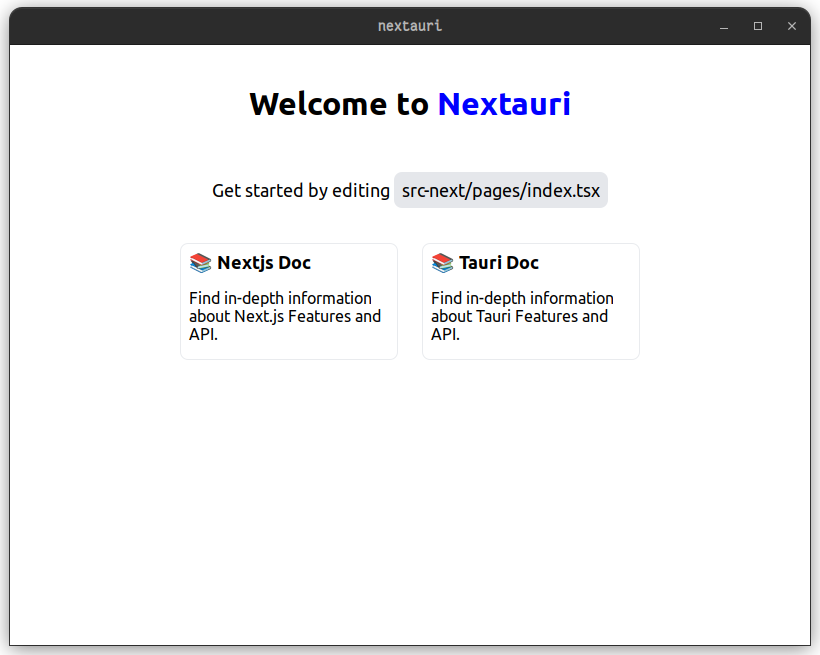Nextauri is your favorite template for create cross-platform application using Tauri with Next.js.
It came with minimal best practice setup so you can add anything fit your need.
You can it use to develop Windows, Linux and Mac desktop application.
But Tauri plan to have a mobile compatibility in the futur !
Nextauri integrates community-endorsed best practices with powerful tooling out of the box:
- Community-recommended ESLint configuration for Next.js projects
- Rust best practices enforced through Clippy linter for Tauri
- GitHub Actions workflows that trigger when pushing and creating pull request:
-
Next.js project linting with ESLint
-
Tauri project analysis with Clippy
-
Production builds for all platforms:
• Linux
• Windows
• macOS
-
- Automated weekly dependency updates keeping your stack fresh
Tauri is great to make secure cross platform application backed by Rust !
It will load an HTML page inside a Webview and give the ability to do system call with IPC.
If you are familliar with electron or nextron you can see it as a very good replacement with smaller bundle size, smaller memory usage and more secure.
That make Next.js the perfect fit for bundle React application with Tauri since it comes with great Static-Site Generation SSG capability that will allow us to generates static files that will be included in the final binary.
The benefit of using Next.js SSG mode is pre-rendered React code in static HTML/JavaScript.
This means your app will load faster.
React doesn't have to render the HTML on the client-side but will hydrate it on the first load if needed.
The downside is that we cannot use getServerSideProps or use any type of data fetching for rendering our page for a request.
Instead we will use getStaticProps to generate our page at build time.
Note that if you still want the power of Rust for generate your page you may have a look at Neon.
It will allow you to call Rust code from Node.js !
Be sure you have NodeJS and Rust installed on your system
-
See Tauri prerequisites to prepare your system to build
Tauri -
Clone or fork this repository
git clone https://github.com/leon3s/nextauri cd nextauri -
Install node dependencies
npm install
To get started you only need one command
npm run devThis will start both Tauri and Next.js in development mode.
Note that tauri is waiting for an http server to be alive on localhost:3000.
It's the default Next.jsportwhile running in development
You can modify the port by updating src-tauri/tauri.conf.json.
"beforeDevCommand": "npm run next dev -- -p 8080",
"devPath": "http://localhost:8080",src-next/are where Next.js files are located.src-tauri/contain Tauri source files.
To test your application we recommand you to use Cypress using Tauri mocking technique.
If you want me to add Cypress as part of the template react to this discussion.
You may also want to take a look to pre-alpha WebDriver Testing from Tauri.
To build in production you can do it in a single command. This will build and export Next.js and build Tauri for your current environnement.
npm run tauri buildLook into src-tauri/tauri.conf.json to tweak the settings,
and refer to Tauri building documentation for more information.
If you are new to Next.js beware when working with it in development !
It will start a Nodejs server in background in order to have HMR (Hot Module Replacement) capability but also SSR (Server Side Rendering).
That mean your React/Typescript code have two execution context :
-
On the
Server- Code is executed by Node.js runtime.
- There is no notion of
windowornavigatorit's part ofBrowser API - You cannot call
Tauri APIin this context since Tauri injection happen in theBrowserside
-
On the
Browser- Code is executed by the Tauri
Webview Tauri APIwill work fine and any otherBrowser APIpackaged3.jsfor example
- Code is executed by the Tauri
Note that your production code will alway be running in a Browser side context.
Since we use the SSG feature from Next.js no Node.js server will be packaged in production.
referenceError: navigator is not defined
This error can orcur when importing @tauri-apps/api for example.
There is 2 workarounds that you can use :
-
Dynamic component method
-
Create your component
import React from 'react' import { window } from '@tauri-apps/api'; const { appWindow } = window; export default function MyComponent() { <div> {appWindow.label} </div> }
-
Import your component
import dynamic from "next/dynamic"; const MyComponent = dynamic(() => import("./path/to/my/component"), { ssr: false, });
-
-
Is browser method
import { invoke } from '@tauri-apps/api/tauri' const isBrowser = typeof window !== 'undefined' if (isBrowser) { /// Code will only execute on browser side }
In general to safely invoke Tauri API you should use it in componentDidMount, useEffect or on user based events that will be alway executed in client side.
To learn more about Tauri and Next.js, take a look at the following resources:
- Tauri Guides - guide about Tauri.
- Tauri API - discover javascript Tauri api.
- Next.js Documentation - learn more about Next.js.
- Next.js Tutorial - interactive Next.js tutorial.




